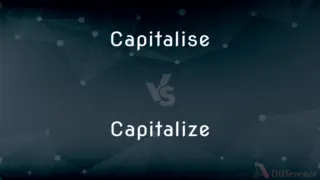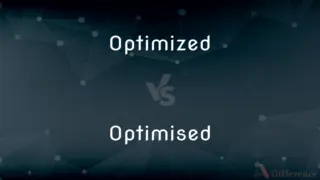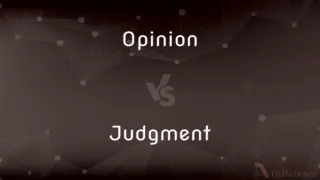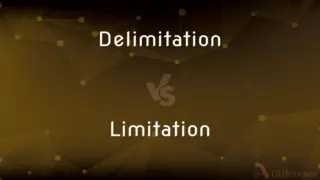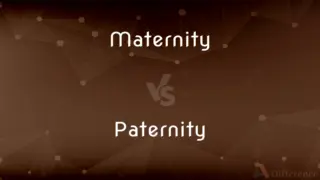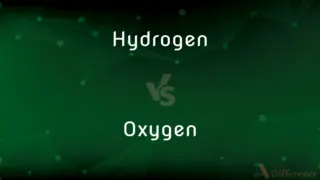Glen vs. Valley — What's the Difference?
By Tayyaba Rehman & Fiza Rafique — Updated on April 26, 2024
A glen is a narrow, secluded valley often found in mountainous areas, typically formed by glacial or fluvial processes, while a valley is a broader low area between hills or mountains, formed by river or tectonic activities.
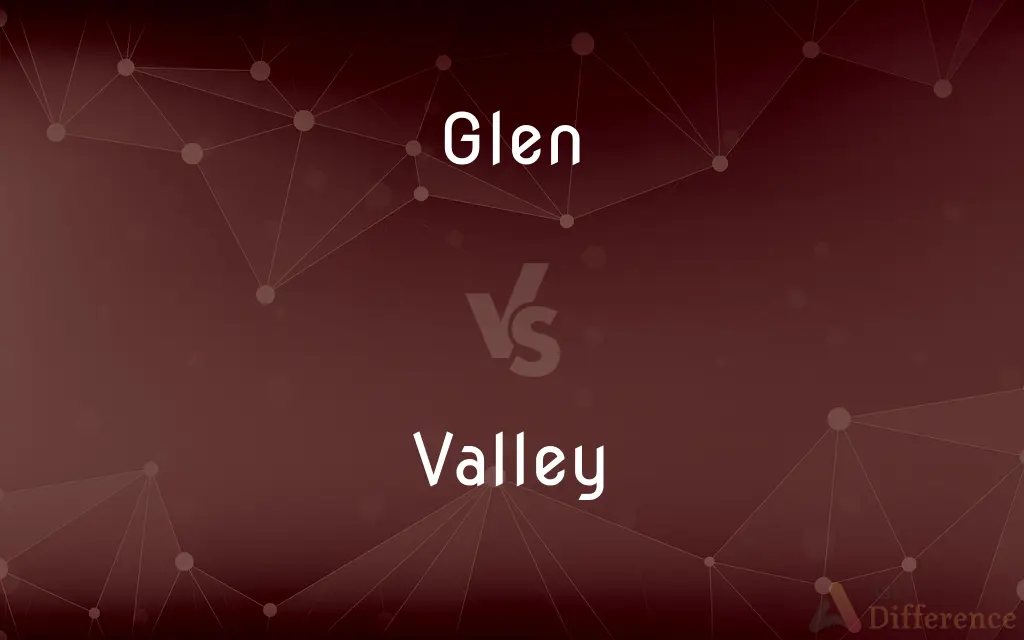
Difference Between Glen and Valley
Table of Contents
ADVERTISEMENT
Key Differences
A glen is typically narrower and more enclosed compared to most valleys, offering a more sheltered environment. Valleys, on the other hand, are generally wider and can vary significantly in size, encompassing vast areas of land.
While glens are often characterized by their steep sides and can be quite deep in relation to their width, valleys have a more varied topography and can be either deep or shallow, wide or narrow, depending on geological factors.
Glen environments are frequently associated with smaller streams or rivers, often originating from springs or runoff from higher elevations. Valleys, whereas, are usually defined by larger rivers which can be significant waterways supporting diverse ecosystems and human settlements.
The term "glen" is particularly common in Scotland and Ireland, indicative of its Celtic origins, implying a secluded and wooded nature. In contrast, "valley" is a more universally used term, applicable to a wide range of geographical contexts worldwide.
Glens are typically less populated and more isolated, providing a habitat that is often untouched and wild. Valleys often host larger communities and are integral to agriculture and industry due to the fertile land and water availability.
ADVERTISEMENT
Comparison Chart
Width
Narrow, confined.
Broad, expansive.
Geological Formation
Often formed by glacial or fluvial erosion.
Formed by river erosion or tectonic activities.
Water Features
Typically features small streams or brooks.
Often houses major rivers.
Common Location
Frequently found in mountainous regions.
Found in various landscapes, including plains.
Cultural Significance
Associated with Celtic regions like Scotland.
Widely recognized and named worldwide.
Compare with Definitions
Glen
Refers specifically to narrow valleys in Scotland and Ireland with steep sides.
The castle overlooked a lush, wooded glen.
Valley
An extensive area of low land between hills or mountains, often with a river running through it.
The valley was ripe with orchards.
Glen
A narrow and secluded valley, especially in mountainous areas.
The hikers camped in the sheltered glen.
Valley
Symbolic of openness and community in contrast to the isolation of a glen.
The festival drew visitors from across the valley.
Glen
A valley that is typically long, deep, and often has a watercourse running through it.
A mist hung over the quiet glen.
Valley
Can be formed through tectonic forces or erosion by a river.
The fertile valley supports extensive farming.
Glen
Symbolic of picturesque and undeveloped nature spots.
They enjoyed a picnic in the serene glen.
Valley
Often serves as the basis for human settlements due to fertile soil and water availability.
Several small towns thrived in the expansive valley.
Glen
Used in poetry and literature to evoke a sense of isolation and natural beauty.
Legends tell of ancient heroes who wandered these glens.
Valley
A term used to describe any elongated depression between uplands.
Snow dusted the peaks surrounding the valley.
Glen
A glen is a valley, typically one that is long and bounded by gently sloped concave sides, unlike a ravine, which is deep and bounded by steep slopes. Whittow defines it as a "Scottish term for a deep valley in the Highlands" that is "narrower than a strath".
Valley
A valley is an elongated low area often running between hills or mountains, which will typically contain a river or stream running from one end to the other. Most valleys are formed by erosion of the land surface by rivers or streams over a very long period of time.
Glen
A narrow valley, especially in Scotland or Ireland.
Valley
A low area of land between hills or mountains, typically with a river or stream flowing through it
The valley floor
The Thames Valley
Glen
A small, secluded valley.
Valley
An internal angle formed by the intersecting planes of a roof, or by the slope of a roof and a wall.
Glen
A secluded and narrow valley, especially one with a river running through it; a dale; a depression between hills.
Valley
An elongated lowland between ranges of mountains, hills, or other uplands, often having a river or stream running along the bottom.
Glen
A secluded and narrow valley; a dale; a depression between hills.
And wooes the widow's daughter of the glen.
Valley
An extensive area of land drained or irrigated by a river system.
Glen
A narrow secluded valley (in the mountains)
Valley
A depression or hollow resembling or suggesting a valley, as the point at which the two slopes of a roof meet.
Valley
An elongated depression cast between hills or mountains, often garnished with a river flowing through it.
Valley
An area which drains itself into a river.
Valley
Any structure resembling one, e.g. the interior angle formed by the intersection of two sloping roof planes.
Valley
To form the shape of a valley.
Valley
The space inclosed between ranges of hills or mountains; the strip of land at the bottom of the depressions intersecting a country, including usually the bed of a stream, with frequently broad alluvial plains on one or both sides of the stream. Also used figuratively.
The valley of the shadow of death.
Sweet interchangeOf hill and valley, rivers, woods, and plains.
Valley
The place of meeting of two slopes of a roof, which have their plates running in different directions, and form on the plan a reëntrant angle.
Valley
A long depression in the surface of the land that usually contains a river
Common Curiosities
Can glens be found outside of Scotland and Ireland?
While the term is most commonly used in Scotland and Ireland, similar landforms exist worldwide but might be called by other names.
Are valleys important for agriculture?
Yes, valleys are often vital for agriculture due to the fertile soil and ample water supply found in many river valleys.
How does a valley differ from a glen in terms of size?
Valleys are generally broader and can encompass larger geographical areas, while glens are narrower and more confined.
What is the typical origin of a glen?
Glens are typically formed by the erosive action of glaciers or rivers, carving narrow valleys between mountains.
Why are glens significant in Celtic cultures?
Glens hold cultural significance in Celtic regions due to their frequent mentions in folklore and their picturesque, often wild landscapes, symbolizing natural beauty and historical mystique.
What role do rivers play in forming valleys?
Rivers are a primary agent in valley formation, eroding the landscape over geological timescales, and shaping the valley floors through sediment deposition.
What is a glen?
A glen is a narrow, secluded valley, often with steep sides and a stream running through it, typically found in mountainous areas.
What types of ecosystems can be found in valleys?
Valleys can support a wide range of ecosystems, from arid deserts to fertile river basins, depending on their climate and geographical location.
How does human settlement in glens compare to valleys?
Glens, being more secluded and narrower, typically have fewer and smaller human settlements compared to valleys, which often have larger communities and more developed infrastructure.
Can a valley also be a cultural symbol?
Yes, valleys often symbolize fertility, community, and the convergence of cultures, especially in areas where they form central aspects of the landscape and human habitation.
Share Your Discovery

Previous Comparison
Conversely vs. However
Next Comparison
Description vs. AnalysisAuthor Spotlight
Written by
Tayyaba RehmanTayyaba Rehman is a distinguished writer, currently serving as a primary contributor to askdifference.com. As a researcher in semantics and etymology, Tayyaba's passion for the complexity of languages and their distinctions has found a perfect home on the platform. Tayyaba delves into the intricacies of language, distinguishing between commonly confused words and phrases, thereby providing clarity for readers worldwide.
Co-written by
Fiza RafiqueFiza Rafique is a skilled content writer at AskDifference.com, where she meticulously refines and enhances written pieces. Drawing from her vast editorial expertise, Fiza ensures clarity, accuracy, and precision in every article. Passionate about language, she continually seeks to elevate the quality of content for readers worldwide.














